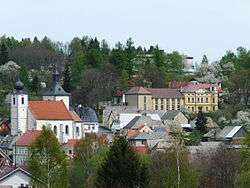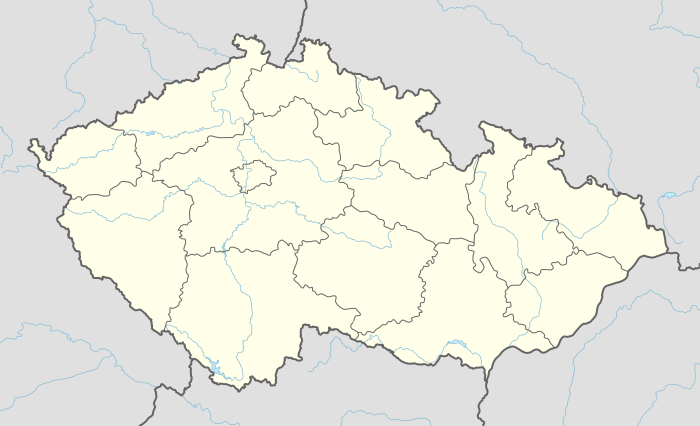Velhartice
Velhartice (German: Welhartitz) is a village in the Czech Republic dating to the 13th century, dominated by the Gothic Velhartice Castle. The castle was built 1290-1310 by a nobleman who later became courtier and close friend of the Emperor Charles IV (1316-1378). During the Thirty Years' War, Emperor Ferdinand II gave the castle to one of his generals, Don Balthazar de Marradas who, in 1628, sold it to Don Martin de Hoeff Huerta who bought it for his beautiful adopted daughter Anne-Marie of Moldavia.
Velhartice | |
|---|---|
Municipality | |
 Church of the Nativity of the Virgin Mary and the municipal office building | |
 Coat of arms | |
 Velhartice | |
| Coordinates: 49°16′N 13°24′E | |
| Country | |
| Region | Plzeň |
| District | Klatovy |
| Area | |
| • Total | 27.20 km2 (10.50 sq mi) |
| Elevation | 622 m (2,041 ft) |
| Population (2018) | |
| • Total | 829 |
| • Density | 30/km2 (79/sq mi) |
| Postal code | 339 01 |
| Website | http://www.velhartice.cz |
In 1790s, the Desfours family, who at the time also owned the castle, built a paper-making factory in Velhartice which, during the World War II, made sleeping bags for the German Army. A leather-tanning factory opened in 1882 and during the Second World War provided leather for military boots made in the neighbouring town. In 1945, several armoured units of George S. Patton's Third Army were stationed in Velhartice. The last owner of the Velhartice castle, Prince Windisch-Graetz, was expelled to Austria in 1946. Presently the castle is claimed by the Czech Republic.
- Archival resources of Velhartice are located in the regional archive in Klatovy (SOkA Klatovy) including the oldest municipal register dating to the very end of the 14th century and privileges issued among others by Don Martin de Hoeff-Huerta and his daughter.
Gallery
| Wikimedia Commons has media related to Velhartice. |
.jpg)
.jpg)
.jpg)